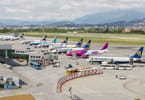BANGKOK, Thailand – According to a recent report from PATA, international arrivals into the Asia Pacific region during February rose 5 percent compared to last year.
The Pacific Asia Travel Association (PATA) today released preliminary figures for international visitor arrivals showing February demand growth was to a certain degree impacted by the shift of the Lunar New Year from the middle of the month in 2010 to the first week of the month this year.
South Asia continued to set the pace with the strongest arrivals growth from among the four sub-regions covered in February with a gain of 15%. Two destinations involved in the hosting of the ICC Cricket World Cup 2011, India and Sri Lanka, recorded the fastest arrivals growth of 15% for the month. Arrivals to the Maldives (+13%) and Nepal (+12%) also grew strongly in February.
Travel demand to Southeast Asia remained robust with arrivals to the sub-region growing by 10 percent year-on-year, with the majority of the destinations recording double-digit gains in arrivals, led by Cambodia (+22%), Myanmar (+29%), and Vietnam (+22%).
Northeast Asia on the other hand registered a significantly slower growth of 3 percent for the month, but added 1.4 million more visitors. Chinese Taipei (+17%) maintained strong inbound growth but growth for other destinations in the sub-region were modest ranging from 2 percent (China, Hong Kong SAR, and Japan) to 5 percent (Macau SAR).
International arrivals to the Pacific rose 4 percent in February 2011, with Australia registering a marginal decline (–0.2%) and New Zealand posting flat inbound growth of 0.2 percent. Arrivals to Vanuatu and Hawaii surged 71% and 12% respectively but the Marshall Islands and Northern Marianas reported double-digit declines for the month.
Said Kris Lim, Director, Strategic Intelligence Centre, PATA: “For the first 2 months of the year, inbound growth was 6 percent. Moderating growth was to be expected following last year’s impressive recovery. Going forward, economic fundamentals remain strong and the positive momentum is expected to continue but the aftermath of the tragic earthquake and tsunami in Japan and the political unrest in the Middle East and North Africa are expected to have a dampening effect on travel demand in the short-term.
The latest figures from JNTO showed that both Japan’s inbound and outbound demand fell sharply in March, by 50% and 18% respectively. Hopes are for a quick return to normalcy sometime from June onwards as the larger part of the country is not affected by the earthquake and tsunami and the on-going issues at the Fukushima Daiichi nuclear power plant.
“The Middle East market provides some 3 million visitors to Asia Pacific annually. It is a significantly smaller origin market but one that has enjoyed robust growth in the past five years. This year the political unrest has caused some drops in visitor numbers to Asia Pacific. One of the leading destinations for Middle East travelers in the region, Thailand, recorded a 15% fall in arrivals from that region in March 2011. Nevertheless, we are confident of continued growth in overall arrivals to the region in the near-term due to the market dynamics and are hopeful of some form of recovery in the Japan and the Middle East markets in the second half of this year,” added Lim.
Asia & the Pacific includes the following sub-regions for the purposes of press releases: Northeast Asia = China, Chinese Taipei, Hong Kong SAR, Japan, Korea (ROK), Macau SAR and Mongolia; Southeast Asia = Cambodia, Indonesia, Lao PDR, Malaysia, Myanmar, Philippines, Singapore, Thailand and Vietnam; South Asia = Bhutan, India, Maldives, Nepal, Pakistan and Sri Lanka; The Pacific = Australia, Cook Islands, Fiji, Kiribati, Marshall Islands, New Caledonia, New Zealand, Niue, Northern Marianas,Palau, Papua New Guinea, Samoa, Tahiti, Tonga, Tuvalu and Vanuatu
Results are preliminary. All comparative figures are year-on-year unless otherwise stated.
WHAT TO TAKE AWAY FROM THIS ARTICLE:
- Going forward, economic fundamentals remain strong and the positive momentum is expected to continue but the aftermath of the tragic earthquake and tsunami in Japan and the political unrest in the Middle East and North Africa are expected to have a dampening effect on travel demand in the short-term.
- Nevertheless, we are confident of continued growth in overall arrivals to the region in the near-term due to the market dynamics and are hopeful of some form of recovery in the Japan and the Middle East markets in the second half of this year,” added Lim.
- The Pacific Asia Travel Association (PATA) today released preliminary figures for international visitor arrivals showing February demand growth was to a certain degree impacted by the shift of the Lunar New Year from the middle of the month in 2010 to the first week of the month this year.





















